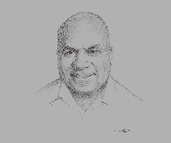Papua New Guinea received 193,000 visitors in 2015. What explains this relatively low number?
KULANG: There are a number of reasons, but the main one is that the country has not been marketed properly over the years. There is a negative perception of the country as a tourism destination, because of law and order problems. I suppose we could be compared to Fiji in this part of the world, a country that receives 1m tourists a year, but certainly not to Australia or South-east Asia, which have developed the sector over the years and can now reap the benefits of this early effort. For too long in PNG, administrations have been content to tap the extractive industries to fuel the national economy, as opposed to developing sustainable industries like tourism and agriculture.
This has to change, and we are fully aware of that fact. Fiji, for example, spends $30m a year on its marketing campaign, while our budget amounts to only $2m. This clearly has to be addressed if we want to spearhead an industry that could create thousands of jobs in PNG. The funding has to reflect the political will. For this reason, the plan is to increase the allocation for tourism in the 2017 budget to $5m.
How could the tourism industry help support economic growth in PNG in the long run?
KULANG: Everybody is talking about the lack of foreign exchange at the moment, and inevitably I think of what the situation would be like if we had strategically invested years ago in sustainable industries like tourism, which elsewhere in the world attracts huge amounts of foreign currency. Those funds could clearly have cushioned the current situation.
Chinese tourists alone spent $7bn in Queensland in 2015. Imagine what it would have meant for our economy if we were able to catch just a fraction of that in PNG. They flew over us to get to that market, and we were just spectators. India also offers another chance, as tourism is opening up, following the growth of the middle class, and we should be at the forefront of that market. Being heavily reliant on minerals and hydrocarbons means that we are always exposed to the fluctuations of commodity prices, and that equals poor planning in my opinion.
As an administration we need to be on the attacking front now when it comes to tourism. We cannot afford to be passive anymore. This is a very competitive industry indeed, where countries endowed with natural beauty and rich cultures fight for every dollar of investment. We will have to be in that game too, because we have plenty to offer as a tourist destination, and it is time to be creative about it.
What are the attractions of PNG as a tourism destination, and what practical measures need to be introduced to spearhead the industry?
KULANG: PNG is virtually undiscovered, and visiting it is a raw experience. This has enormous appeal in a world where mass tourism has often left a scar on destinations worldwide. PNG is still physically intact, as are its unique cultures. These aspects of the country need to be protected as well as exposed to the outside world.
In terms of practical measures, making the destination more affordable is definitely at the top of the agenda. This means creating more competition in the airline industry, as it continues to be very expensive to fly in and out of the country. There is also the need to produce far more capacity in the hospitality industry, especially in light of the 2018 APEC conference to be hosted in Port Moresby.
The conference requires at least 15,000 beds, whereas currently we only have 2500 available. Lastly, we should separate the activities between marketing, which is the competence of the Tourism Promotion Authority, and the ministry, which should concentrate on policy issues. I am saying this because in the past the two overlapped, and we cannot afford it anymore. We need a clear alignment and we need leadership.


